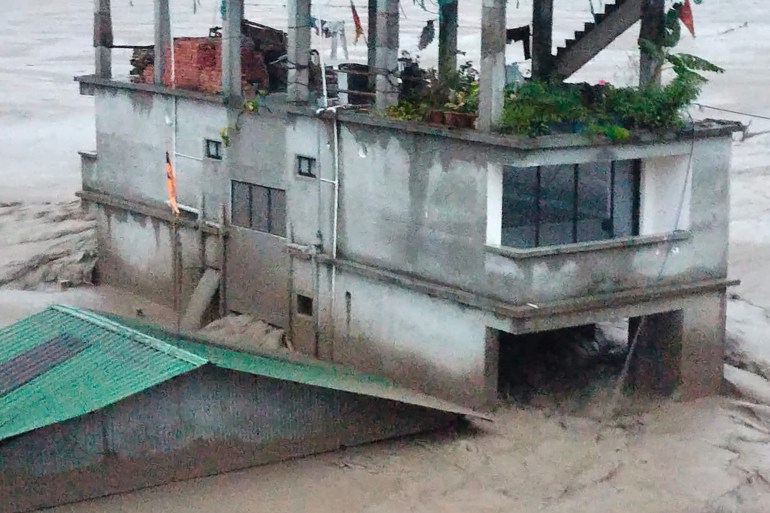Floods in India’s Sikkim kill 10; dozens including 23 army soldiers missing
Heavy rainfall causes a glacial lake to overflow, spurring catastrophic flooding in the remote Himalayan region.
At least 10 people have been killed in India’s state of Sikkim and 82 others, including 23 army personnel, are missing after heavy rainfall caused the glacial Lhonak Lake to overflow, spurring catastrophic flooding in the region.
The northeastern state received 40.9mm (1.6 inches) of rainfall between Tuesday and Wednesday morning, according to the India Meteorological Department (IMD) – about five times its normal rate of 8.6mm (0.3 inches) for this time of the year.
“So far, 10 bodies have been recovered from different locations. At least 82 more are missing and 22 people are injured, some of them seriously,” Sikkim’s Chief Secretary V B Pathak told Reuters news agency.
A cloudburst – or an extreme amount of rain over a brief period of time – over Lhonak Lake triggered torrential flooding in the valley located about 150km (93 miles) north of Gangtok near the border with China.

“Intense rain has led to this catastrophic situation in Sikkim where the rain has triggered a glacial lake outburst flood and damaged a dam and caused loss of life and caused further damage to roads and infrastructure,” said Miriam Jackson, a senior cryosphere specialist at the Nepal-based International Centre for Integrated Mountain Development.
The lake, which sits at the base of a glacier in peaks surrounding the world’s third-highest mountain, Kangchenjunga, had shrunk by nearly two-thirds in size overnight, an area roughly equivalent to 150 football pitches (105 hectares), satellite photographs released by the Indian Space Research Organisation showed.
Heavy rainfall hampered the search for the Indian troops reported missing, with the capital city of Gangtok cut off by road, defence officials said.
“Twenty-three personnel have been reported missing and some vehicles are reported submerged under the slush. Search operations are under way,” a defence ministry spokesperson said.

India’s weather department has warned of landslides and disruption to flights as heavy rain is predicted to continue over the next two days in some parts of Sikkim.
Jackson warned that such extreme events have become more frequent “as the climate continues to warm and takes us into unknown territory”.
The main highway linking Sikkim to West Bengal state had collapsed and Gangtok was totally cut off by road, according to army spokesperson Anjan Basumatary.
About 15,000 people living in the vicinity are likely to be affected and at least eight major bridges have been washed away along the banks of the Teesta River, officials said.
Media showed images of the river lashing through the hills and entering residential areas.
Panic situation in Singtam, East Sikkim this morning pic.twitter.com/TANBVf54Lo
— Nitesh R Pradhan (@NiteshRPradhan) October 4, 2023
Some army bases and facilities along the valley were affected and rising water submerged vehicles following the release of water from a dam, a defence ministry spokesperson based in the neighbouring city of Guwahati said.
Intermittent rain and thunderstorms were hampering rescue operations in the area, an army official told Reuters, speaking on condition of anonymity.
Prime Minister Narendra Modi’s office said in a statement that the government will support state authorities in meeting the challenges from the floods.
Violent flooding from glacier lakes dammed by loose rock has become more frequent as global temperatures rise and ice melts, with scientists on Wednesday warning the deadly flood was a taste of further extreme weather events to come.
Disasters caused by landslides and floods are common in India’s Himalayan region during the June-September monsoon season.
The region saw heavy monsoon rains this season, with experts saying climate change is increasing their frequency and severity.
Nearly 50 people died in flash floods and landslides in August in Himachal Pradesh, also a Himalayan state.
Record rains in July killed more than 100 people over two weeks in northern India, as roads were waterlogged and homes collapsed.
In February 2021, flash floods killed nearly 200 people and washed away houses in Uttarakhand.




